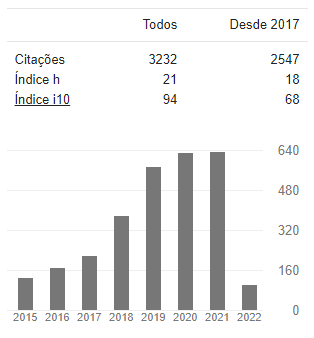RHEOLOGICAL PROPERTIES OF BRINE/VEGETABLE OIL/POLYETHOXYLATED NON-IONIC SURFACTANTS BASED MICROEMULSION
DOI:
https://doi.org/10.15628/holos.2018.6227Palavras-chave:
surfactant, microemulsion, phase diagram, rheologyResumo
This study aimed to develop microemulsion through of ternary system composed of brine (aqueous phase), vegetable oil (oil phase), and non-ionic polyethoxylated surfactants, T20 and T80. From the ternary diagrams obtained, two systems were chosen in the regions of microemulsion (Winsor IV) and, subsequently, were conducted rheological study, at different temperatures, and cloud point studies of these systems. The results showed that the microemulsion of T20/brine/vegetable oil presented thermal stability up to 53° C and microemulsions of T80/brine/vegetable oil of 72o C, that could be due a change in micelle morphology and cloud point of each microemulsion system. The rheological results indicated non-Newtonian behavior, adjusted by Herschel - Bulkley model.
Downloads
Referências
Baruah, A., Pathak, A. K, & Ojha, K. (2015). Phase behavior and thermodynamic properties of lamellar liquid crystal developed for viscoelastic surfactant based fracturing fluid. Chemical Engineering Science, 131, 146-154. doi: 10.1016/j.ces.2015.03.067
Bera, A., Kumar, T., Ojha, K., & Mandal, A. (2014) Screening of micromemulsion properties for application in enhanced oil recovery. Fuel, 121, 198-207. doi: 10.1016/j.fuel.2013.12.051
Daltin, D. (2011). Tensoativos: química, propriedades e aplicações. São Paulo: Editora Blucher.
Karambeige, M. S., Nasiri, M., Asl, A. H., & Emadi, M. A. (2016). Enhanced oil recovery in high temperature carbonates using microemulsions formulated with a new hydrophobic component. Journal of industrial and engineering chemistry, 39, 136 – 148. doi: 10.1016/j.jiec.2016.05.020
Lange, K. R. (1999). Surfactants: A Practical Handbook. Munich: Hanser.
Lee, K. L. (2011). Applications and Use of Microemulsions. Cornell University Library. arXiv:1108.2794 online archive.
Quintero, L., Jones, T., Clark, D. E., & Twynam, A. J. (2007). NAF filter cake removal using microemulsion technology. European Formation Damage Conference Held in Scheveningen, 30 May – 1 June, Netherlands. doi: 10.2118/107499-MS
Quintero, L., Jones, T., Clark, D. E., & Schwertner, D. (2009). Cases History studies of production enhancement in cased hole wells using microemulsion fluids. European Formation Damage Conference Held in Scheveningen, 27-29 May, Netherlands. doi: 10.2118/121926-MS
Quintero, L., Jones, T. A., & Pietrangeli, G. (2011). Phase boundaries of microemulsion systems help to increase productivity. European Formation Damage Conference, 7-10 June, Netherlands. doi: 10.2118/144209-MS
Reed, R. L., & Healy., R. N. (1977). Some physicochemical aspects of microemulsion flooding: a review. Improved oil recovery by surfactant and polymer flooding, 383 -437. doi: 10.1016/B978-0-12-641750-0.50017-7
Rossi, C. G. F. T., Dantas, T. N. C., Dantas Neto, A. A., & Maciel, M. A. M. (2007). Microemulsões: uma abordagem básica e perspectivas para aplicabilidade industrial. Revista Universidade Rural: Ciências Exatas e da Terra, 26, 45 – 66.
Santanna, V. C., Curbelo, F. D. S., Castro Dantas, T. F., Dantas Neto, A. A., Albuquerque, H. S., Garnica, A. I. C. (2009). Microemulsion flooding for enhanced oil recovery. Journal of Petroleum Science and Engineering, 66, 117-120. doi: 10.1016/j.petrol.2009.01.009
Santanna, V. C., Silva, A. C. M., Lopes, H. M., Sampaio Neto, F. A. (2013). Microemulsion flow in porous medium for enhanced oil recovery. Journal of Petroleum Science and Engineering, 105, 116-120. doi: 10.1016/j.petrol.2013.03.015
Winsor, P. A. (1954). Solvent Properties of Amphiphilic Compounds. Butterworths Scientific Publ. Ltd. London.









































